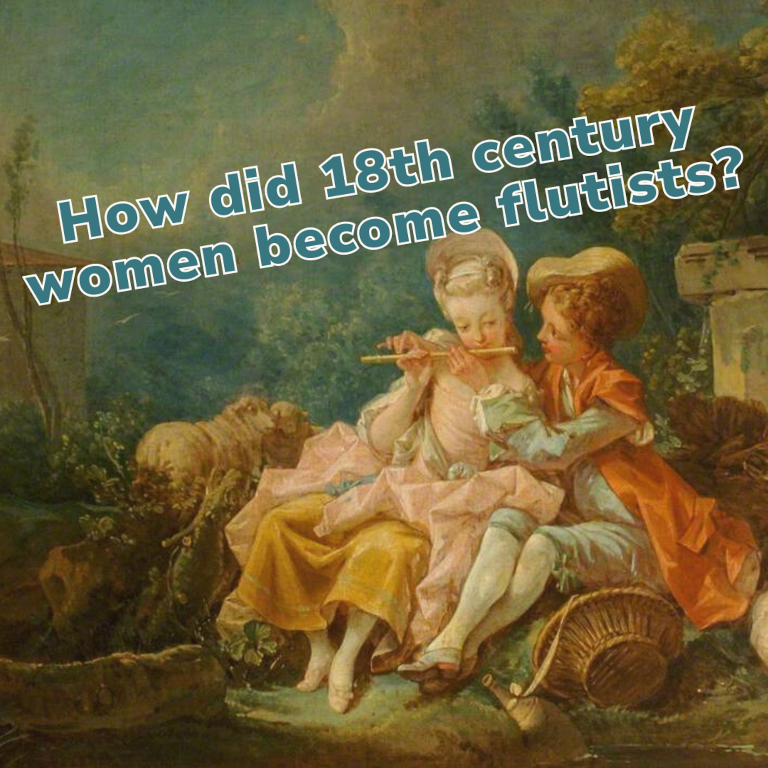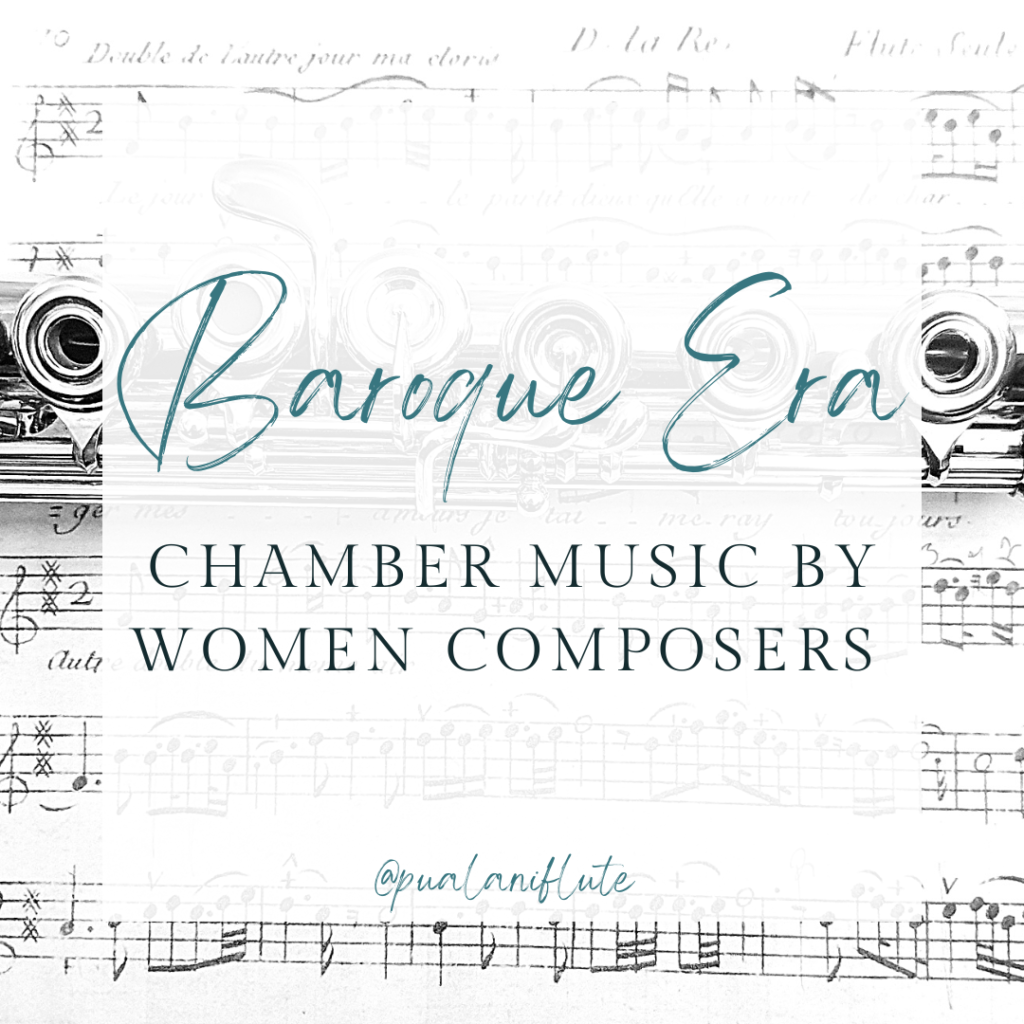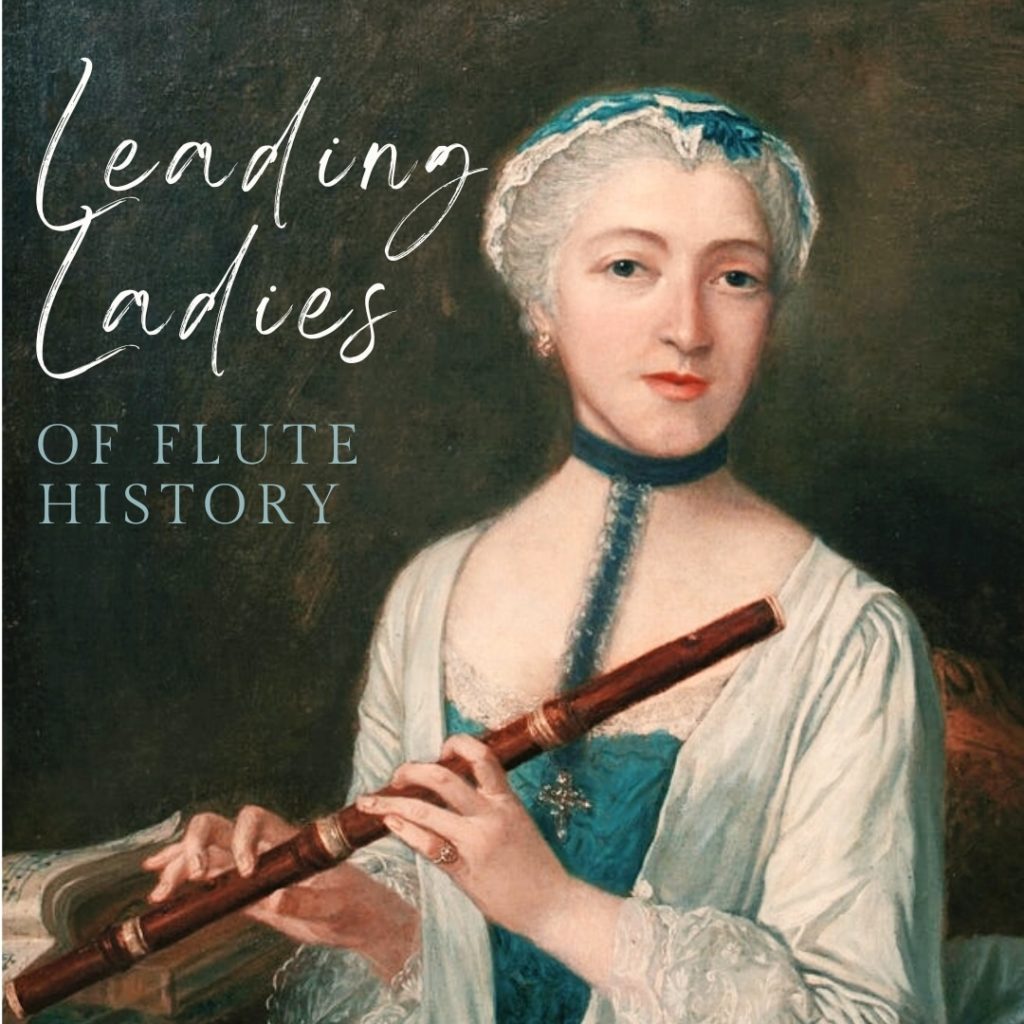I feel like there are a couple contradictory assumptions when it comes to historical flutists – some observe that a majority of modern flutists are women, and assume that’s always been the case, while others notice that most historical flute repertoire was composed by men, and conclude that women flutists were exceptions to the rule.
The latter can lead to the impression that women flutists were extremely rare. However, the Common Practice Period spanned several centuries with a range of social norms and ideologies – which also affected the way that musical women pursued their careers.

The 1700s was a time before many European revolutions, the Industrial Revolution, and early capitalism – so if you lived during the Enlightenment and wanted to become a flutist or a composer of flute music, what’s a girl to do? Your options would depend greatly on your family’s economic class and social circle – but even the most practical options might sound foreign to modern ears. Let’s start by taking a look at why that may be.
Music as a Trade
The Industrial Revolution didn’t begin until around 1760 – about a decade after the Baroque era ended. Trades and apprenticeships were still the norm, and many businesses were arranged around generations of families. That’s not to say that there weren’t entrepreneurial ventures – but new enterprises tended to be taken on by couples with resources (like land or inheritance) as a joint venture between marriage partners.

In modern times, we commonly think of musical employment in terms of gigs – but in the early 1700s, day labor and gig work (and by extension, the possibility of a career as an individual) was just starting to become more common. The musicians in surviving records tended to be virtuosos who toured major cities, composers and family ensembles employed by court patrons, or members of religious institutions. (This is partly a bias in written records – anything from this era that was made to last and/or actively preserved was expensive to create, and therefore came from noble courts or the church).
Our modern concept of professionalism didn’t come about until the 1800s, with the development of capitalism. Music education was not yet institutionalized, as modern conservatories did not yet exist. Although Enlightenment-era academies typically catered to upper-class white men, apprenticeships created opportunities for young women to learn from other female musicians – and I’ve seen several sources suggest that gendered restrictions in musical activities were not as big of a deal before the turn of the 19th century.
Marriage
When talking about historical women, it’s also important to take a more objective look at marriage. Back in the 1700s, marriage functioned as a cheat sheet for social organization that determined the economic role each family member contributed – it was more of a practical business arrangement than the love-match it’s commonly seen as today.

Ready-made products weren’t a thing yet, so there was a lot of important behind-the-scenes work involved in maintaining a household, business, or plot of land. The head of family, his wife, unmarried relatives, widows with inheritance, and youth old enough to learn trades or work the field, all fulfilled different familial duties.
In this era, it simply wasn’t possible to do everything yourself, so your network of relatives was super important. And as a result, marriage was the biggest determining factor of the kind of socio-economic resources a woman could access.
A Note on Historical Biases
It’s important to realize that women did have key contributions to Baroque era music even though many common narratives devalue their work. In Victorian times, middle & upper class women tended to minimize any money-making activities in order to appear more respectable – which unfortunately has bled into historical bias in other eras.
The tendency of modern scholars to emphasize written records has only exacerbated this further, as many historical publications were printed under the name of the official business owner – the male head of family. However, just because 18th century women didn’t have individual careers and were limited by patriarchal systems does not mean that their contributions were not known and valued during their lifetimes.
Women’s Musical Careers in the 18th Century
Now that we’ve got a general sense of the 18th century economic environment, let’s take a look at a few career paths open to Baroque era flutists and composers from across the class spectrum in Europe.
Family Ensembles
If you weren’t in the upper class, becoming a musician in a family ensemble was your best bet – and seems to have been a relatively common path among women musicians employed by court patrons. (Though since records these patrons kept are our main source of information about these musicians, we don’t know much about their lives outside of the court gigs).

This manner of employment could come about in a couple different ways. If you were born into a musical family, you learned to play and compose music as you grew up, as an apprentice to an older relative. This was a great opportunity for girls to learn from their mothers and/or other female relatives – role models that young women in later centuries did not always have. If you weren’t born into a musical family, you could marry into one after learning vocational skills relevant to a music-related business (like publishing, instrument-making, or managing an ensemble), to gain access to musical resources and social connections.
But marriage could go both ways – surviving records of musical activities can taper off for women who married out of a musical family (as they joined their husband’s economic ventures in a different trade), or took time off to raise children (whether they married into a musical family or outside of one).
Mlle Taillart & Johanne Sophie Mudrich
Mademoiselle Taillart (surviving records don’t list her first name) came from a family of flutists, and most likely learned to play the flute at home from her father. Although Pierre Évrard Taillart later became the most famous member of their family, Mlle Taillart was the first woman instrumentalist to perform at the Concert Spirituel on 1 November, 1735.
And she wasn’t the only one – Johanne Sophie Mudrich, who also came from a family of musicians, performed at the Concert Spirituel on Christmas Eve, 1779, during a stop on her way back from a tour of Germany. Unfortunately, not much is known about these women apart from their concert records.

The Concert Spirituel was a concert series for the upper class hosted at the Tuileries Palace in Paris. Performances were held on religious holidays, to provide entertainment while other venues in the city were closed. Although women flutists were not super common in the 1700s, it seems unlikely that these two would have been allowed to perform in concerts like this if it was truly considered improper.

The women’s orchestra of the Ospedale della Pietà performs from the balcony (upper left) at a gala concert commemorating a visit from Russian nobility.
Convents and Orphanages
If you weren’t connected to a musical family and/or didn’t want to marry, your best bet was to join a religious institution with a music program for girls and women. The most famous example is the Ospedale della Pietà in Venice, one of four ospedale grandi that were renowned across Europe for their all-female ensembles. The Ospedale was a convent, music school, and orphanage. Their female residents had the option to learn music, which offered them the opportunity to practice instruments that they would not have otherwise been allowed. They could also learn conducting and composition, though they were only allowed to perform within the Ospedale walls.
Anna Bon di Venezia
Although most girls were admitted to the Ospedale as infants, they also took on a few “figlia di spese” and “figlia d’educazi” – talented youth sponsored by a wealthy patron to study music. Anna Bon became one of the latter after a successful audition at age four, sponsored by her grandfather while her parents (travelling court musicians) were employed in Moscow.
After graduation, Anna joined her family at the court of Bayreuth, where she became their first ‘Chamber Music Virtuosa.’ The Margrave of Bayreuth was a student of Quantz, and although not a flutist herself, Anna wrote an opus each of flute sonatas and divertimenti while in his employ.

Records drop off when the Bons left Bayreuth following the Margravine’s death in 1758 – the family appears in opera productions in Pressburg, Nuremberg, and Einstadt, but the last mention of Anna is her marriage to an Italian singer in 1767.
Anna Amalia, Princess of Prussia
Instead of arranging a marriage for his youngest sister, Frederick the Great secured a position for Anna Amalia as the Abbess of Quedlinberg in 1755 – giving her not only financial security, but also the time and resources to devote to musical pursuits and support other musicians as a patron.
Anna Amalia had initially learned music in secret with her brother, who gifted her a flute in the 1740s. Although she was proficient on that instrument, she became more well-known for playing keyboard and organ. She took a great interest in the music of J.S. Bach, and curated a library of over 600 scores that have become invaluable to modern scholars. Her Flute Sonata in F Major is one of her few surviving works.


Frederick the Great’s sisters, Anna Amalia von Preußen and Wilhemline von Bayreuth, were also accomplished instrumentalists and composers.
Music Salons
Finally, if you came from an upper-class family, you could host your own music salon. These were the precursors to Classical and Romantic era salons, and a bit more exclusive. (Although these events happened in private, the nobility were also seen as cultural ‘tastemakers,’ and following their trends was like keeping up on celebrity news today. However, there was not quite the same kind of public/private divide that we see established during early capitalism).
Although social restrictions of the upper class would prevent you from performing for money (and therefore, you’d technically be an amateur musician), you’d have the resources to afford music lessons, commission new music, and put on your own performances. In addition, a high social status may have engendered more leniency towards musical pursuits that were less common for women at the time, like playing flute or composing.
While 18th century salons tended to center chamber music featuring harp, lute, voice, and keyboard instruments, it was not yet the piano-heavy genre it became in the 1830s. And their hostesses were responsible for many commissions and historical scores that have been preserved through the present day.
Wilhelmine von Bayreuth
Wilhelmine von Bayreuth was the eldest sister of Frederick the Great and Anna Amalia. She learned music in secret, like her siblings, and became an accomplished lutenist, harpsichordist, and composer. Although Wilhelmine was known for opera and chamber music, she also painted, acted, directed, and wrote staged works.
Some sources say that she learned flute, too – but not all of the references I’ve seen corroborate that, so as far as I’m concerned, the jury’s still out. However, she did write several flute sonatas (though only the Sonata in a minor survives) and would sometimes accompany her brother.

As a patron of the arts, Wilhelmine built a theater and founded the University of Erlangen with her husband, the Margrave of Bayreuth (she was also a mentor to Anna Bon, whom I mentioned earlier). In this case, Wilhelmine not only had the advantage of being born into nobility, but also came from a family with tons of musical connections and married a spouse who was an (amateur) musician.
Trailblazing Successes
Like Wilhelmine von Bayreuth, many of these women actually fell into a few different categories. That probably has something to do with why they became successful enough that they’re still remembered today – they had access to a LOT more resources than your average 18th century woman. However, their paths to success leave clues as to how other women from that era may have gone about navigating musical pursuits.
Although 18th century women couldn’t just opt into musical training the way we choose college majors today, it certainly wasn’t impossible for them to become flutists and composers within the socio-economic conventions of their time. And despite the patriarchal bias, they were able to achieve many important milestones that helped blaze a trail for women in later times.
To continue exploring the world of Baroque women flutists and composers, check out the additional resources below!
Additional Resources
Playlist – 18th Century Flute Concerts
A playlist from my YouTube channel inspired by surviving records of 18th century concert programs featuring women flutists, flute music from composers associated with those women’s families, and women composers who wrote music for flute students of Johann Joachim Quantz.
Baroque Era Chamber Music by Women Composers
A repertoire guide to trio sonatas and music for small ensembles by 18th century women composers featuring the flute!
Historical Women Flutists: From Astley to Taillart
Read about other trailblazing women flutists from the Baroque and Classical eras!

